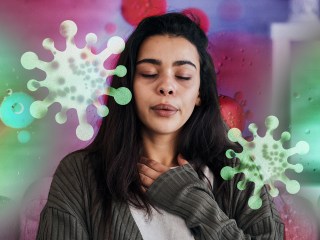Glimmers Might Be Your New Favorite Mental Health Hack
These flickers of comfort are often hyped as the “opposite of triggers.”
Social media can be a hotbed of wellness trends that don’t always serve your mental health, but here’s a mental fitness trend that’s having a moment on TikTok and is actually useful: glimmers, or little—often spontaneous—moments that fill you with a sense of safety and joy.
So, what are glimmers?
Glimmers can be pretty much anything, but if you’re having a hard time wrapping your brain around this concept think about how good it feels when you spot a friendly pup at a party, hear your fave throwback in a store, get caught up enjoying a conversation with someone, or spot a cloud in a funny shape. Yep, those are all glimmers.
These flickers of comfort, if you will, are often hyped as the “opposite of triggers” by mental health pros on TikTok, meaning they’re thoughts, feelings, situations, or literally anything that make you feel good and maybe even mindful. (To be fair, triggers can bring up positive and negative responses, but since we tend to think of them as causing bad ones, this tracks.)
Glimmers are rooted in polyvagal theory, aka the theory of how the nervous system impacts mental health, says Deb Dana, LCSW, who coined the term in 2018. And there’s credibility to this mindfulness practice, says clinical psychologist Nina Polyné, PsyD. Keeping an eye out for glimmers may even help counteract people’s natural tendency to focus on negative experiences, she adds. This exercise can help us “get back into the body instead of being so caught up in our thoughts.” If you make a habit of it, you might actually be able to train your brain to seek out the things that make you feel happy and secure—and who couldn’t use more of that?
But it isn’t all rainbows, sunshine, and toxic positivity (aka dismissing your negative thoughts and feelings so you can pretend everything is very much fine). Letting more glimmers into your life doesn't discount past trauma, says Dana, who attributes this ~glimmers resurgence~ to how challenging it can be to feel safe these days. “There are plenty of reasons why someone might feel unsafe in today’s world,” Dana says, but she adds that “our nervous system has this beautiful capacity to hold all the trauma experiences and find micro-moments of safety and connection—those glimmers.”
How can you add more glimmers to your life?
So while glimmers were initially a concept that was developed to help people who have experienced trauma, anybody can benefit from being open to finding glimmers. If you’re down, try setting the intention to look for things that make you happy today. There’s no shame in starting with a small goal, like finding even one glimmer. Chances are you’ll feel so good when you accomplish it that you might just want to try again the next day. Though glimmers are typically thought of as unpredictable moments you stumble upon throughout your day, sometimes getting out in the world is asking for a lot. So if you’re staying inside or wanna keep the curtains drawn, or if you’ve noticed zero glimmers by the end of the day, look at a picture of nature (sounds weird, but it works) or listen to some birds chirping to help you feel present. Just maybe don’t go scouring the internet for a glimmer…because you might end up sucked into a doom scroll or slapped with horrible news and images that are not so glimmery.
To get extra juice out of your glimmers, keep a journal of your favorites so you can go back and read about them when you need some positivity in your life. When you’re ready to graduate to the next level, share your glimmers by texting a friend or signing your emails with a glimmer, like Dana does. Not only will it make someone else’s day, it’ll brighten yours—again!—knowing you sprinkled more goodness in the world.
As with any mental fitness exercise, patience and practice is key. “If you’re learning how to sing, you’re not going to be Adele the first time you sing,” Dr. Polyné says. (So sad, but so true.) Spotting these little gems might not happen every day or even every week, so don’t stress. Instead, give yourself props for trying, because strengthening these mind muscles takes time.
Even though you don’t need a therapist to find a glimmer, if you want to know more about them, try talking to a licensed professional about the concept and if it might be something worth adding to your mental health toolkit. Keep in mind that “glimmers” isn’t a clinical term, so you might have to provide some context if they haven’t seen the TikToks.
Need more glimmer-spotting tips?
Want some help finding glimmers in your own life? Here are some tactics worth trying, courtesy of Dr. Polyné and Dana:
- Get outside or look out a window to see what surprises nature has in store today. Think about what you can hear, see, smell, or touch with your hands or feet. Is it an expansive sky and pillowy clouds? A sherbert-colored sunset? A calming breeze? Crunchy leaves on the ground? Morning dew that hasn’t burned off just yet? A fragrant garden?
- Pay extra attention when your adorable pet comes for a cuddle without you coaxing them with a treat.
- Blast some music, dance like no one’s watching, and create a teeny moment of joy—even if it only lasts for the chorus.
- Look through old photos that never fail to make you feel all warm and fuzzy.
- Try a new food and think about the texture, taste, and what’s enjoyable about it.
- Strike up a mindful conversation with someone you love. Then, see if you can stay in the moment and think about what you appreciate about them and how their facial expressions make you feel connected and at ease.
- Notice the artwork or photography in your home, at work, or when you have an office appointment and consider if the images evoke a significant emotion in you.
- Turn up your favorite podcast and focus on the host’s tone of voice and what soothes you or makes you feel comfortable and at ease.
- Hang on to the warm, connected feeling you might get when a stranger smiles at you as you pass them.
- Listen to the passionate sound of your own voice as you sing along to your favorite song. Maybe you are the next Adele!
- Go people watching and hone in on a stranger's unique style, the way they put their look together, and see if you’re inspired to try something new.
- Curl up with a warm towel fresh out of the dryer.
Wondermind does not provide medical advice, diagnosis, or treatment. Any information published on this website or by this brand is not intended as a replacement for medical advice. Always consult a qualified health or mental health professional with any questions or concerns about your mental health.




